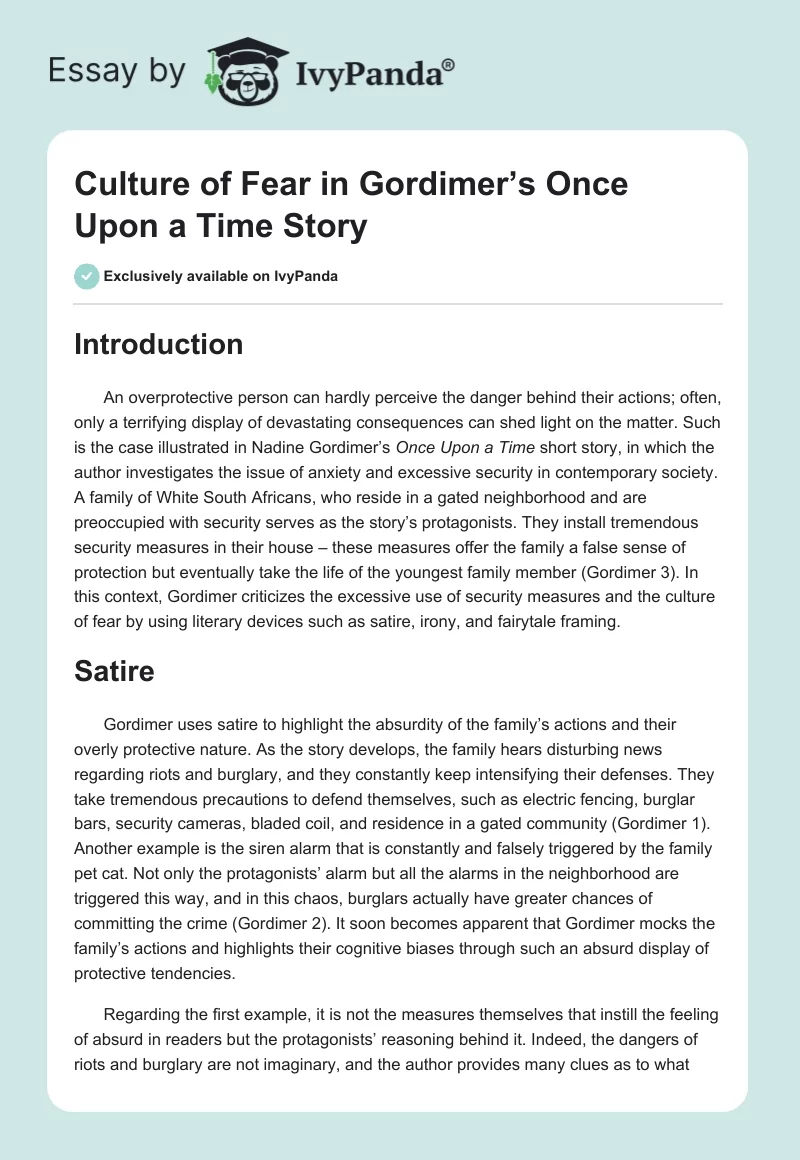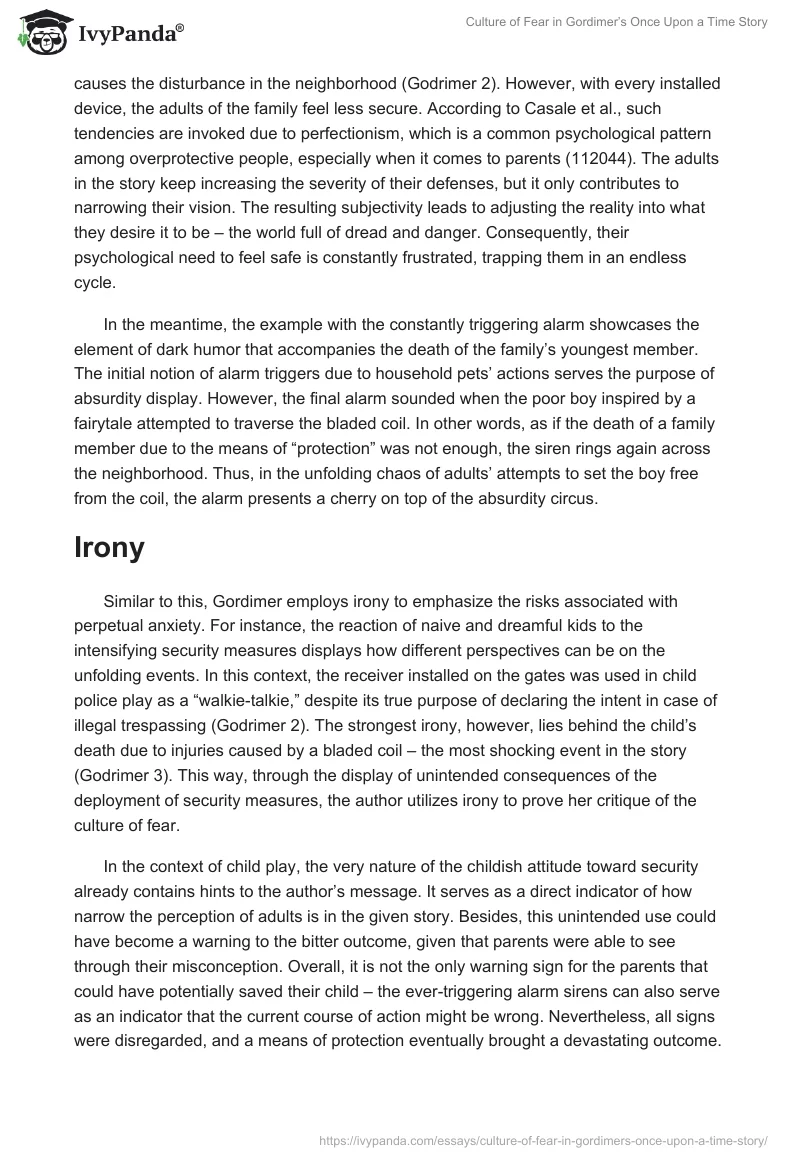Introduction
An overprotective person can hardly perceive the danger behind their actions; often, only a terrifying display of devastating consequences can shed light on the matter. Such is the case illustrated in Nadine Gordimer’s Once Upon a Time short story, in which the author investigates the issue of anxiety and excessive security in contemporary society. A family of White South Africans, who reside in a gated neighborhood and are preoccupied with security serves as the story’s protagonists. They install tremendous security measures in their house – these measures offer the family a false sense of protection but eventually take the life of the youngest family member (Gordimer 3). In this context, Gordimer criticizes the excessive use of security measures and the culture of fear by using literary devices such as satire, irony, and fairytale framing.
Satire
Gordimer uses satire to highlight the absurdity of the family’s actions and their overly protective nature. As the story develops, the family hears disturbing news regarding riots and burglary, and they constantly keep intensifying their defenses. They take tremendous precautions to defend themselves, such as electric fencing, burglar bars, security cameras, bladed coil, and residence in a gated community (Gordimer 1). Another example is the siren alarm that is constantly and falsely triggered by the family pet cat. Not only the protagonists’ alarm but all the alarms in the neighborhood are triggered this way, and in this chaos, burglars actually have greater chances of committing the crime (Gordimer 2). It soon becomes apparent that Gordimer mocks the family’s actions and highlights their cognitive biases through such an absurd display of protective tendencies.
Regarding the first example, it is not the measures themselves that instill the feeling of absurd in readers but the protagonists’ reasoning behind it. Indeed, the dangers of riots and burglary are not imaginary, and the author provides many clues as to what causes the disturbance in the neighborhood (Godrimer 2). However, with every installed device, the adults of the family feel less secure. According to Casale et al., such tendencies are invoked due to perfectionism, which is a common psychological pattern among overprotective people, especially when it comes to parents (112044). The adults in the story keep increasing the severity of their defenses, but it only contributes to narrowing their vision. The resulting subjectivity leads to adjusting the reality into what they desire it to be – the world full of dread and danger. Consequently, their psychological need to feel safe is constantly frustrated, trapping them in an endless cycle.
In the meantime, the example with the constantly triggering alarm showcases the element of dark humor that accompanies the death of the family’s youngest member. The initial notion of alarm triggers due to household pets’ actions serves the purpose of absurdity display. However, the final alarm sounded when the poor boy inspired by a fairytale attempted to traverse the bladed coil. In other words, as if the death of a family member due to the means of “protection” was not enough, the siren rings again across the neighborhood. Thus, in the unfolding chaos of adults’ attempts to set the boy free from the coil, the alarm presents a cherry on top of the absurdity circus.
Irony
Similar to this, Gordimer employs irony to emphasize the risks associated with perpetual anxiety. For instance, the reaction of naive and dreamful kids to the intensifying security measures displays how different perspectives can be on the unfolding events. In this context, the receiver installed on the gates was used in child police play as a “walkie-talkie,” despite its true purpose of declaring the intent in case of illegal trespassing (Godrimer 2). The strongest irony, however, lies behind the child’s death due to injuries caused by a bladed coil – the most shocking event in the story (Godrimer 3). This way, through the display of unintended consequences of the deployment of security measures, the author utilizes irony to prove her critique of the culture of fear.
In the context of child play, the very nature of the childish attitude toward security already contains hints to the author’s message. It serves as a direct indicator of how narrow the perception of adults is in the given story. Besides, this unintended use could have become a warning to the bitter outcome, given that parents were able to see through their misconception. Overall, it is not the only warning sign for the parents that could have potentially saved their child – the ever-triggering alarm sirens can also serve as an indicator that the current course of action might be wrong. Nevertheless, all signs were disregarded, and a means of protection eventually brought a devastating outcome.
Fairytale Framing
Despite the story’s grim setting and climax, Gordimer constantly portrays the narration as a fairytale. Particularly, the title Once upon a Time, a conventional fairytale format, and continuous mentioning of “living happily ever after” create a strong contrast of contradicting concepts (Gordimer 2). As was mentioned before, the protagonists are a family of White South Africans who grew up in a gated neighborhood during the violent and lawless apartheid era. The family’s strict security measures are a mirror of the country’s broader cultural problems with segregation, violence, and fear at the time (Van Riet 86). According to Van Riet, the onset of democratic rule was strongly associated with the institutional weakness of the country (81). A particular notion is that numerous private security agencies received great proliferation due to police forces’ inability to stabilize the situation (Van Riet 81). Thus, the family’s socioeconomic situation and race were the main causes of their worry and paranoia, which is reasonably justified.
The peculiarities of the author’s contemporary societal circumstances are showcased at the very beginning of the story, prior to the discussed “fairytale.” The story within the story belongs to a female novelist who was woken up by the commotion in her house. Unaware of the actual causes of the noise, the novelist assumes there might be a thief coming into her room (Gordimer 1). The assumption is not groundless, as the author also mentions the murder case that had recently occurred in the proximity of the novelist’s home (Gordimer 1). This disturbing setup provides a staging ground for the reasoning of the following “fairytale” events.
The content of the story, however, deliberately defies the conventions of a fairytale genre in order to warn against the perils of perpetual terror. In this context, if the story had a traditional happy ending, the message would not be able to reach the readers. Potentially, the whole point of Once Upon a Time would have to be changed in order to accommodate actual “happily ever after.” In turn, to criticize the fundamental contemporary socioeconomic and cultural problems within a different genre, the author would have to apply literary tools in a completely different way. That is, fairytale framing perfectly justifies the use of satiric hyperbole. In other words, the chosen framing method highlights how ridiculous the family’s actions are, which is further combined with a substantial contrast between the traditional happy and actual endings of Once Upon a Time. As a result, the combination allows the author to draw readers’ attention to the matter in a concise and efficient manner.
Conclusion
Overall, Once Upon a Time by Nadine Gordimer can be considered a potent critique of the culture of fear and excessive security in our society. Gordimer exposes the family’s errors in reasoning and emphasizes the perils of living in continual terror by employing satire, irony, and fairytale framing. The moral of the story emphasizes the value of facing one’s concerns and interacting with the outside world. With the use of these literary devices, Gordimer invites readers to consider the effectiveness of overzealous security measures and to adopt a more impartial and nuanced perspective on the issue of fear and security.
Questions
What is the name of your story?
The name of the story is Once Upon a Time.
What topic did you choose to discuss in your paper?
In my paper, I have chosen to discuss the topic of the devasting consequences that can occur due to one’s overreaction to defeat or danger.
How does the author show this?
The author utilizes various literary devices, such as satire, irony, and fairytale framing, to shock her readers and underline the message behind depicted terrifying events.
Is your thesis arguable?
Given that one should reverse the polarity behind family’s actions from negative to positive in order to argue my thesis, I do not find my thesis reasonably arguable.
Write your preliminary thesis below.
Gordimer criticizes the excessive use of security measures and the culture of fear by using literary devices such as satire, irony, and fairytale framing.
Works Cited
Casale, Silvia, Giulia Fioravanti, and Simon Ghinassi. “Applying the Self-Determination Theory to Explain the Link between Perceived Parental Overprotection and Perfectionism Dimensions.” Personality and Individual Differences, vol. 204, 2023, p. 112044.
Gordimer, Nadine. “Once Upon a Time.” FLIPHTML5, 1989, Web.
Van Riet, Gideon. “Intermediating between Conflict and Security: Private Security Companies as Infrastructures of Security in Post-Apartheid South Africa.” Politikon, vol. 47, no.1, 2020, pp. 81-98.


